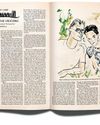Prøve GULL - Gratis
THE CURRENT CINEMA SHOCK WAVES
The New Yorker
|July 31, 2023
“Oppenheimer” and Barbie.”

The new film from Christopher Nolan, “Oppenheimer,” starts and ends in the round. In the opening shot, ripples expand in puddles as raindrops fall. Three hours later, we get a vision of Earth beginning to burn, as nuclear explosions bloom across the globe. Nolan is always entranced by the vast and the tiny; “Inception” (2010), wherein city streets fold like paper under the pressure of dreams, concludes with a spinning top. This obsession with scale is well served by “Oppenheimer,” in which the amassing of refined uranium, for the construction of an atomic bomb, is indicated by marbles piling up inside a goldfish bowl. How much roundness can you take?
The antidote to this circularity is J. Robert Oppenheimer. (Though named for his father, Julius, he insisted, with Prufrockian nicety, that the “J” stood for nothing at all.) Lean, sticklike, skullish in his gauntness, and too clever for comfort—his own or anyone else’s—he has gone down in history as the director of the Los Alamos Laboratory, in New Mexico, where the bomb was built, and it is from history that Nolan seeks to pluck him. Oppenheimer is played by Cillian Murphy, who catches the quiet inquietude of the man, and his tobaccosoftened speech. In the blaze of his blue eyes we see not candor but a kind of undimmed shock, as if he were staring straight through us at matters invisible to regular mortals. “What happens to stars when they die?” he says, by way of small talk, at a party in Berkeley. There he meets the incandescent Jean Tatlock (Florence Pugh); later, at her bidding, he translates a Sanskrit text as they make love. For Oppenheimer, no talk is ever small.
Denne historien er fra July 31, 2023-utgaven av The New Yorker.
Abonner på Magzter GOLD for å få tilgang til tusenvis av kuraterte premiumhistorier og over 9000 magasiner og aviser.
Allerede abonnent? Logg på
FLERE HISTORIER FRA The New Yorker

The New Yorker
THE TALK OF THE TOWN
The militarization of American cities, including Los Angeles, Portland, and Chicago, has brought home a perverse irony. T
4 mins
October 20, 2025

The New Yorker
THIS IS MISS LANG
The brief life and forgotten legacy of a remarkable American poet.
19 mins
October 20, 2025

The New Yorker
RAMBLING MAN
Peter Matthiessen's quest to escape himself—at any cost.
15 mins
October 20, 2025

The New Yorker
DEGREES OF HOSTILITY
How far will the Administration's assault on colleges and universities go?
26 mins
October 20, 2025

The New Yorker
GOINGS ON
What we're watching, listening to, and doing this week.
6 mins
October 20, 2025

The New Yorker
READY OR NOT
Zohran Mamdani wants to transform New York City. Will the city let him?
37 mins
October 20, 2025

The New Yorker
Alexandra Schwartz on Joan Acocella's "The Frog and the Crocodile"
When I am stuck on a sentence or trying to wrestle an idea into shape, I turn to Joan Acocella.
3 mins
October 20, 2025

The New Yorker
A BROTHER'S CONVICTION
Did a grieving man's quest for justice go too far?
43 mins
October 20, 2025

The New Yorker
THE KEY TO ALL MYTHOLOGIES
Why the quest for a master code goes on.
13 mins
October 20, 2025

The New Yorker
FOR ART'S SAKE
\"Blue Moon\" and \"Nouvelle Vague.\"
6 mins
October 20, 2025
Translate
Change font size
